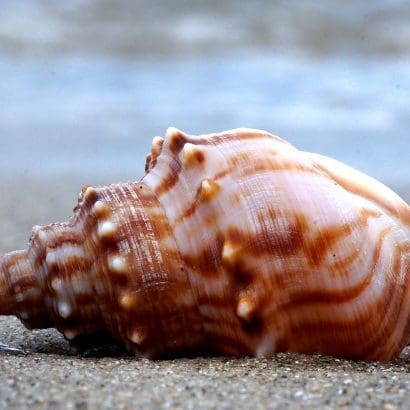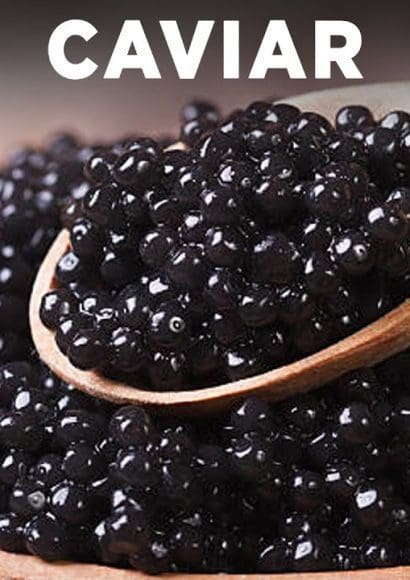
Caviar, often regarded as the epitome of culinary luxury, is a delicacy that has captivated the palates of gourmands for centuries. Derived from the roe (eggs) of sturgeon, this exquisite delicacy has a long-standing reputation as a symbol of indulgence and opulence. From its rich and buttery flavor to its elegant appearance, caviar has become synonymous with refined taste and sophistication.
In this article, we embark on a journey to unravel the allure of caviar and delve into the world of this luxurious culinary delight. We will explore its origins, traditions, and the meticulous process involved in obtaining these precious sturgeon roe. Additionally, we will discover the different varieties of caviar, each with its own unique characteristics and flavor profiles.
As we venture further, we will uncover the art of savoring caviar, exploring the best serving temperatures, and pairing it with complementary accompaniments to enhance its delicate taste. Moreover, we will examine the prominent role of caviar in haute cuisine, where renowned chefs elevate this delicacy to new heights of gastronomic excellence.
Contents
Origin and Tradition.
The origin of caviar can be traced back to ancient times, where it was consumed as a delicacy by various cultures around the world. However, it was the Caspian Sea region, particularly Russia and Iran, that became renowned for producing the finest caviar.
For centuries, sturgeon, the fish species responsible for producing caviar, thrived in the Caspian Sea and its surrounding rivers. The local populations recognized the value of sturgeon roe and developed techniques to extract and preserve it. The consumption of caviar became deeply ingrained in the culinary traditions of these regions, often associated with special occasions and celebrations.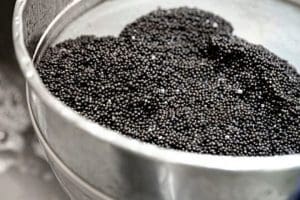
In Russia, caviar held immense significance and was an integral part of Russian cuisine. The Russian tsars and aristocracy indulged in this luxurious delicacy, and it became a symbol of wealth and prestige. The beluga, osetra, and sevruga sturgeon species found in the Caspian Sea were highly sought-after for their prized roe.
Varieties of Caviar.
Caviar comes in various types and is classified based on the species of sturgeon and the region of origin. Each variety possesses distinct characteristics that contribute to its unique flavor profile and texture. Let’s explore some of the most popular varieties of caviar:
Beluga Caviar:
Beluga caviar is often considered the epitome of luxury. It is derived from the roe of the Beluga sturgeon, one of the largest and rarest species of sturgeon. Known for its large, lustrous eggs ranging in color from light gray to black, beluga caviar is prized for its smooth, buttery texture and delicate flavor.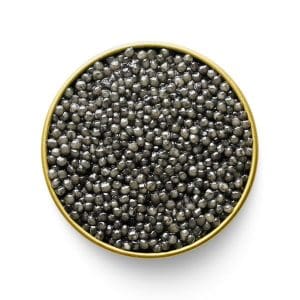
Osetra Caviar:
Osetra caviar is obtained from the Osetra sturgeon and is highly regarded for its rich, nutty flavor. The eggs of Osetra caviar vary in color, ranging from golden to dark brown. The size of the eggs can also differ, with smaller grains offering a crisp texture, while larger grains provide a creamy mouthfeel.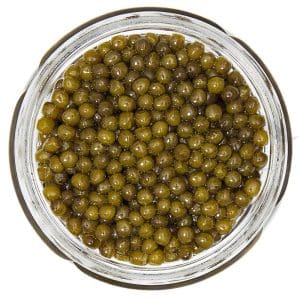
Sevruga Caviar:
Sevruga caviar is sourced from the Sevruga sturgeon, which is smaller in size compared to other sturgeon species. It features small to medium-sized eggs with a grayish-black color. Sevruga caviar is known for its robust and intense flavor, often described as briny and slightly earthy.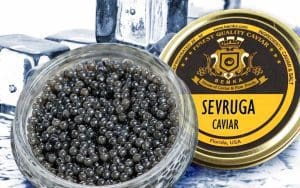
Kaluga Caviar:
Kaluga caviar, also known as River Beluga caviar, is a relatively new and highly sought-after variety. It is obtained from the Kaluga sturgeon, which shares similarities with the Beluga sturgeon. Kaluga caviar exhibits large, glossy eggs that range in color from light to dark gray. It offers a rich, buttery flavor reminiscent of traditional Beluga caviar.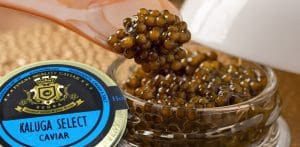
Siberian Caviar:
Siberian caviar comes from the Siberian sturgeon, a species native to the rivers of Siberia. It is known for its small to medium-sized eggs with a dark gray to black color. Siberian caviar offers a balanced flavor profile, combining elements of both nuttiness and brininess. It is often considered a more affordable alternative to other premium caviar varieties.
American Caviar:
In recent years, American caviar has gained recognition for its quality and flavor. Sourced from different species of sturgeon found in American rivers and lakes, such as Hackleback, Paddlefish, and White Sturgeon, American caviar offers a range of taste profiles. It is often characterized by a robust, earthy flavor and a variety of egg colors, including dark brown, gray, and black.
Obtaining Process.
The process of obtaining caviar is a meticulous and delicate one, requiring precision and expertise to ensure the highest quality and flavor of the final product. Let’s explore the general steps involved in the caviar obtaining process: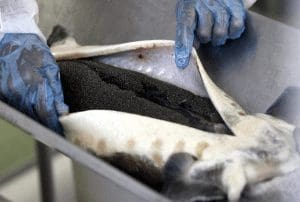
Sturgeon Harvesting:
The process begins with the careful harvesting of sturgeon. In the case of wild sturgeon, fishing regulations and sustainable practices are followed to protect sturgeon populations. In recent years, the focus has shifted towards caviar produced from sturgeon in aquaculture farms, where the fish are bred and raised in controlled environments.
Roe Extraction:
Once the sturgeon is harvested, the fish is carefully handled to prevent any damage to the eggs. The roe extraction process typically involves a skilled “caviar master” who uses a specialized technique to remove the eggs from the sturgeon. The abdomen of the fish is delicately opened, and the roe is gently collected. This step requires precision to ensure the integrity and quality of the eggs.
Egg Preparation:
After the roe is extracted, it undergoes a meticulous cleaning process. The eggs are carefully rinsed with cold water to remove any impurities or excess membranes. The goal is to maintain the natural flavor and texture of the caviar without compromising its quality.
Salting:
Salt plays a crucial role in the caviar preparation process. The cleaned roe is delicately salted to enhance the flavor and act as a natural preservative. The salt is typically a non-iodized variety, such as sea salt, which is gently applied to the roe. The amount of salt used can vary depending on the desired taste profile and the expertise of the caviar producer.
Maturation:
After salting, the caviar is left to mature in temperature-controlled environments. This maturation period allows the flavors to develop and intensify. The duration of maturation can range from a few weeks to several months, depending on the type of caviar and the desired flavor profile.
Packaging and Storage:
Once the caviar has reached its desired maturity, it is carefully packaged for distribution and sale. The caviar is typically placed in airtight containers, such as tins or jars, to maintain its freshness and prevent any oxidation. Proper storage conditions, including refrigeration at specific temperatures, are crucial to preserve the quality and flavor of the caviar.
Tasting and Pairing.
When it comes to enjoying caviar, the art of tasting and pairing is essential to fully appreciate its delicate flavors and textures. Here is some general information about the process of tasting caviar and the art of pairing it with complementary accompaniments:
Tasting Caviar:
Tasting caviar is a sensory experience that involves savoring the nuanced flavors, textures, and aromas of the roe. Here are some key steps to follow when tasting caviar:
Temperature:
Serve caviar chilled but not excessively cold. The ideal temperature is between 28 to 32°F (-2 to 0°C). This temperature range allows the flavors to develop without being overwhelmed by extreme coldness.
Utensils:
Use a non-metallic spoon, such as mother-of-pearl, horn, or plastic, to avoid altering the taste of the caviar.
Texture:
Take a small amount of caviar with the spoon and gently place it on your tongue. Allow the eggs to roll over your taste buds and experience the unique texture. Note the firmness, creaminess, or delicacy of the eggs.
Flavor:
Pay attention to the flavor profile of the caviar. Notice the initial taste, whether it is buttery, nutty, briny, or subtly sweet. Allow the flavors to linger on your palate and appreciate any lingering aftertastes.
Pairing Caviar:
Pairing caviar with the right accompaniments enhances the overall experience and brings out the best in both the caviar and the accompanying flavors. Here are some popular pairings:
Blinis:
Blinis are small, fluffy pancakes that serve as a classic base for caviar. The mild, slightly sweet flavor of blinis complements the rich and salty taste of caviar.
Crème Fraîche:
The tangy and creamy nature of crème fraîche provides a delightful contrast to the briny and buttery caviar. It acts as a cooling agent that enhances the overall flavor experience.
Toast Points:
Thinly sliced, lightly toasted bread or crackers offer a neutral base for caviar. Their subtle flavors and crisp texture allow the caviar to shine.
Traditional Garnishes:
Traditional garnishes like finely chopped red onions, chives, or hard-boiled egg whites can add a touch of freshness and texture to the caviar.
Champagne and Vodka:
The effervescence and crisp acidity of champagne, particularly brut or extra brut varieties, provide a delightful contrast to the rich and creamy flavors of caviar. Additionally, vodka’s clean and smooth characteristics can also complement the taste of caviar.
Caviar in Haute Cuisine.
Caviar holds a revered status in the world of haute cuisine, where it is celebrated as a symbol of luxury and sophistication. Renowned chefs and fine dining establishments around the globe incorporate caviar into their culinary creations, elevating dishes to new levels of decadence. Here is some general information about the use of caviar in haute cuisine:
Enhancing Flavor and Texture:
Caviar is prized for its unique flavor and delicate texture, which can elevate a dish from ordinary to extraordinary. Chefs often use caviar as a garnish or accent to add a burst of brininess, richness, and complexity to their creations. The firm yet delicate eggs provide a delightful pop and a luxurious mouthfeel that enhances the overall dining experience.
Presentation and Visual Appeal:
Caviar’s glossy appearance and striking colors make it an exquisite ingredient for visually stunning presentations. Chefs carefully place caviar atop dishes, creating a captivating focal point that entices diners even before the first bite. The elegant and luxurious aesthetic of caviar adds a touch of opulence to any culinary masterpiece.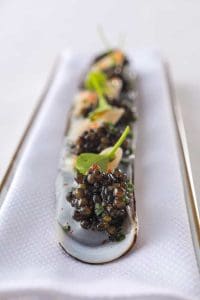
Versatile Applications:
Caviar’s versatility allows it to be incorporated into a wide range of haute cuisine dishes. It pairs well with various ingredients, including seafood, poultry, vegetables, and even desserts. Chefs use caviar creatively, incorporating it into amuse-bouches, canapés, sushi, pasta, soups, and more. Its delicate flavor allows it to harmonize with other ingredients, creating a symphony of tastes on the plate.
Innovative Combinations:
Haute cuisine often pushes the boundaries of traditional flavors and combinations, and caviar plays a part in this culinary exploration. Chefs experiment with unconventional pairings, combining caviar with unexpected ingredients such as foie gras, truffles, smoked salmon, oysters, and even chocolate. These imaginative combinations provide intriguing contrasts and enhance the complexity of flavors in haute cuisine creations.
Signifying Luxury and Exclusivity:
Caviar’s reputation as a luxurious delicacy has made it a symbol of extravagance and exclusivity in haute cuisine. It is associated with special occasions, celebrations, and extraordinary dining experiences. The presence of caviar on a menu signals the utmost attention to detail, quality ingredients, and exceptional craftsmanship.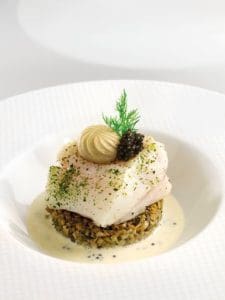
Sustainability and Responsible Sourcing:
As awareness of sustainability grows, chefs and establishments in haute cuisine emphasize the importance of responsible sourcing and sustainable caviar production. They seek out suppliers who prioritize the well-being of sturgeon populations and employ ethical farming practices. This commitment ensures that caviar remains a coveted ingredient for future generations.
Caviar: An Icon of Opulence and Culinary Artistry in Haute Cuisine.
Caviar, with its exquisite flavor, delicate texture, and luxurious reputation, has rightfully earned its place as an icon of opulence and culinary artistry in the world of haute cuisine. Renowned chefs and fine dining establishments recognize the unique qualities of caviar and skillfully incorporate it into their creations, transforming dishes into extraordinary culinary experiences.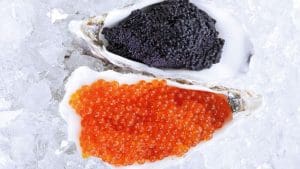
In the realm of haute cuisine, caviar goes beyond being a mere ingredient; it becomes a symbol of refinement and sophistication. Its presence on a menu signifies a commitment to exceptional quality, meticulous craftsmanship, and attention to detail. Caviar’s glossy appearance, ranging from shades of gray to black, adds an element of visual allure, making each dish a work of art.
The versatility of caviar allows it to seamlessly integrate into various culinary applications. It harmonizes with a myriad of ingredients, from delicate seafood and succulent poultry to vibrant vegetables and even sweet desserts. Chefs push the boundaries of creativity, experimenting with innovative combinations that surprise and delight the palate.


